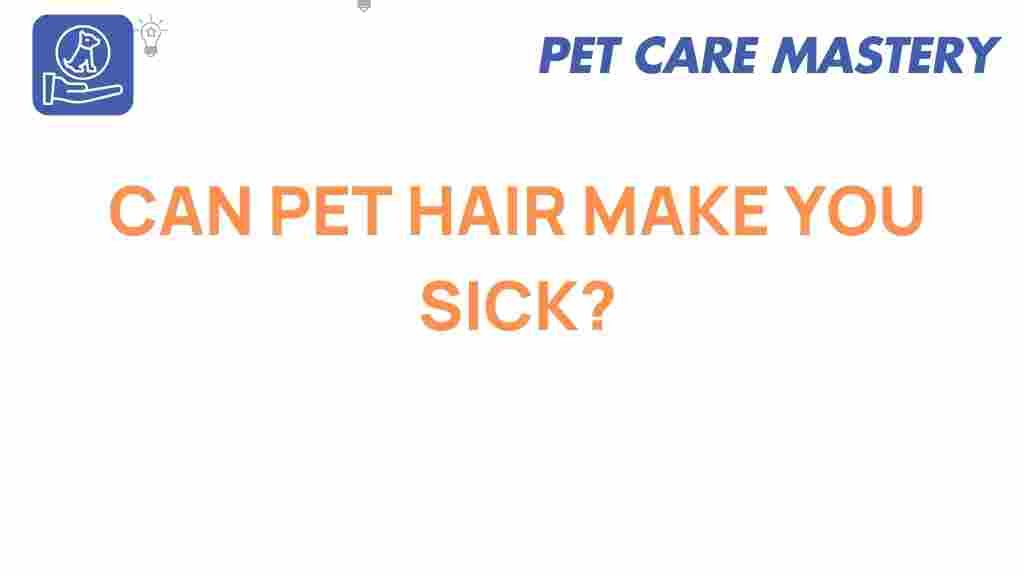Can Pet Hair Really Make You Sick?
As pet owners, we adore our furry companions, but there’s a lingering concern that many people have: can pet hair actually make you sick? With millions of households harboring dogs, cats, and other pets, it’s essential to understand the implications of pet hair on our health. In this article, we will dive deep into the surprising truth about pet hair, exploring the potential health risks, how to manage them, and tips for maintaining a healthy living environment with pets.
Understanding Pet Hair and Its Composition
Pet hair is essentially a collection of dead skin cells, oils, and, of course, hair from our beloved animals. For many, this is just a natural part of pet ownership. However, pet hair can be a carrier for other allergens and irritants that might lead to health issues. Here’s what you need to know:
- Allergens: Pet hair can trap allergens, such as pollen, dust, and mold spores, which may exacerbate allergies or respiratory issues.
- Parasites: Fleas, ticks, and mites can hitch a ride on pet hair, potentially leading to skin irritations or more serious infections.
- Microbes: Pet hair can harbor bacteria and viruses, especially if your pet has been outdoors.
The Connection Between Pet Hair and Allergies
Many people are allergic to pets, but it’s not the hair itself that triggers the reaction. Instead, it’s proteins found in pet saliva, urine, and skin. When pets groom themselves, these proteins can become airborne and mix with pet hair. This can lead to allergic reactions in sensitive individuals, which may manifest as:
- Itchy, watery eyes
- Runny or stuffy nose
- Skin rashes
- Respiratory problems, including asthma
Can Pet Hair Transmit Diseases?
While pet hair itself isn’t known to transmit diseases directly, it can be a medium for various pathogens. Here are some potential risks associated with pet hair:
- Zoonotic diseases: Some diseases can be transmitted from pets to humans, such as ringworm or toxoplasmosis. Proper grooming and hygiene can help mitigate these risks.
- Infections: Cuts or abrasions that come into contact with pet hair can lead to skin infections if bacteria are present.
- Respiratory infections: As mentioned earlier, pet hair can act as a carrier for allergens and irritants that can lead to respiratory issues.
Step-by-Step Process to Minimize Health Risks from Pet Hair
While pet hair can pose some health risks, there are several proactive steps you can take to minimize exposure and keep your home safe:
1. Regular Grooming
Groom your pets regularly to reduce shedding and minimize the amount of hair in your home. This can be achieved through:
- Brushing your pet frequently
- Bathing them with pet-friendly shampoo
- Using grooming tools designed to reduce shedding
2. Clean Your Home Regularly
Adopt a cleaning routine to keep pet hair at bay. This includes:
- Vacuuming carpets and upholstery with a vacuum designed for pet hair
- Dusting surfaces with a damp cloth to trap allergens
- Washing pet bedding and toys frequently
3. Invest in Air Purifiers
Using high-efficiency particulate air (HEPA) purifiers can help remove pet hair and dander from the air, improving the overall air quality in your home.
4. Designate Pet-Free Zones
Creating areas in your home where pets are not allowed can help reduce the amount of pet hair in spaces where you spend the most time, such as bedrooms or home offices.
5. Maintain Your Pet’s Health
Ensure your pets are regularly checked by a veterinarian to prevent and treat any potential skin conditions, parasites, or infections that could contribute to pet hair-related health issues.
Troubleshooting Common Issues Related to Pet Hair
Even with best practices in place, some challenges may arise. Here are common issues and their solutions:
1. Persistent Allergies
If you or a family member experiences persistent allergies despite cleaning and grooming, consider consulting an allergist for further evaluation and potential allergy treatments.
2. Excessive Shedding
If your pet is shedding more than usual, it could be a sign of stress, poor nutrition, or underlying health issues. Consult your veterinarian to rule out any medical concerns.
3. Difficulty Cleaning Pet Hair
If traditional cleaning methods aren’t effective, consider investing in tools like lint rollers or rubber gloves to help gather hair from furniture and clothing more easily.
Conclusion: Finding Balance with Pet Hair
In conclusion, pet hair can pose some health risks, primarily through the allergens and pathogens it may carry. However, with proper grooming, regular cleaning, and attention to your pet’s health, the risks can be effectively managed. The joy and companionship that pets bring to our lives often outweigh the challenges associated with pet hair. By following the tips provided in this article, you can create a healthier living environment for both you and your furry friends.
For more information on pet care and health, feel free to check out this comprehensive guide. And remember, it’s always a good idea to consult with your veterinarian about any specific concerns you have regarding your pet’s health and hygiene.
So, can pet hair really make you sick? The answer is nuanced, but with proactive measures, you can enjoy all the benefits of pet ownership without compromising your health.
This article is in the category Health and created by PetCareMastery Team
